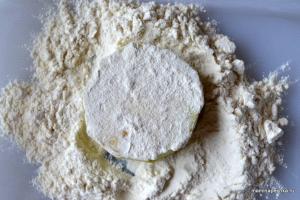If we try to briefly describe what the Greek style is, then its most striking and characteristic symbol will be a circle inscribed in a square - one of the most beloved and often used ornaments by the Greeks. This is the whole Greek style - harmonious, simple, aesthetic, clear and rational.
A characteristic feature of Greek interiors is majestic simplicity; there is no pomp and luxury, an abundance of gilding and bright colors, like in Roman style. But at the same time, all the elements look expensive, but discreet and elegant.
Greek style color scheme
The Greek style is characterized by cold tones - all shades of blue with the addition of green, lemon yellow, white, brown. Basics color combination– alternating white and blue, for example, on a white wall – a blue window frame. Bright colors, such as red-pink, are used as an accent.
Ceilings
Tall, drawing the eye upward, giving a feeling of boundless space and freedom. To add grandeur to the room, the ceiling can be supported by monumental columns decorated stucco. If possible, install a square (round) window in the ceiling to add light to the room. The ceiling itself is finished textured plaster, the tonality of which is in harmony with the color of the walls, but most often the color of the walls and ceiling is identical. At the same time, the ceiling always remains matte - this emphasizes the noble antiquity of the Greek style. Occasionally, meander patterns are applied to the ceiling. Almost always the ceiling frames plinth from artistic stucco.
Advice! Insufficient ceiling height can be compensated by vertical orientation wall decor and interior details that will create an illusory feeling of upward movement, which will visually “raise” the ceiling level.
The heart of the ceiling is massive chandelier hanging on gilded chains, and along the perimeter there are small lamps that favorably highlight and highlight the beauty of the ceiling plinth.
Walls
No wallpaper - they are categorically unacceptable in this direction. To decorate the walls, rough textured plaster is used, which gives the Greek interior a man-made charm and strict simplicity. Ideally, using plaster you can create the visual effect of marble masonry. Sometimes, when decorating walls, a two-layer coating is used - the visible inner layer of textured plaster reproduces the effect of antiquity, creating the impression that time and wind have worked on this wall, leaving their own special indelible imprint.
Another option is to cover the walls with various patterns, with preference given to patterns of broken lines or simple geometric shapes. When monochromatic color scheme Colorful accents can be placed using painted stucco. A common element of wall decoration is frescoes, hand-painted picturesque panels, almost always on a mythological theme.
Columns
Columns are one of the indispensable attributes of the style; without exaggeration, they are a business card and a kind of indicator of the “naturalness” of the Greek style; they add authenticity to the creation of the Greek style in the interior. The colonnade fills the room with an atmosphere of monumentality, grandeur and eternity. But to install this architectural element you will need a room of impressive size and high ceilings.
Otherwise, when due small area it is impossible to install a full-fledged colonnade, you can limit yourself to installing polyurethane pilasters - having a capital and base, they quite accurately, albeit conditionally, display the columns, taking up a minimum of space. In addition, such a vertically oriented element will help to visually “raise” the ceiling plane. Pilasters can be of any shape, both simple (rectangular or semicircular) and quite complex (beam pilasters). Polyurethane pilasters are glued to the wall and then covered with matte white paint - the effect is of a plaster column recessed into the wall.
Floor
IN classic version In Greek interiors, carpets are used in very, very rare cases; sometimes natural sheep skin can be used in their role. But in our conditions it is necessary to somehow soften the cold of the stone floor, so the pattern and colors carpeting should convey the style of Greece. This can be a natural pattern (grapevine, roses) or a geometric pattern (a complex interweaving of broken lines). Colors – natural: blue, olive, white, brown,
An antique pearl, lost between three seas, evokes different but invariably pleasant associations for everyone.
Greek style brings back memories of the Mediterranean breeze and delicacies, famous thinkers, mythical gods and heroes, sports battles and theatrical performances, rich history and unique culture that we inherited from the ancient Hellenes.

All this was fully embodied in the interior design in the Greek style.

Its recognizable features are the harmonious combination the smallest details and sophistication contained in simplicity. That is why even in modern apartment a lover of the classics can find a completely different era.
Basics of interior design
The culture of Ancient Greece went through a rapid process of development and liberation from Egyptian influence in just a hundred years.

Already in the 5th century BC, in the design and architecture of Hellas one can observe the triumph of the “golden mean” - the ideal balance of beauty and practicality.

Each detail had its own special meaning in the aesthetic composition. The basic principles remained unchanged even after several centuries:

White color as the basis of the room design is combined with natural shades environment: most often it is blue color sea wave and pastel tones, as if faded by the sun.

Finishing walls with plaster, stone and rough whitewash - the main thing is that they are not smooth. Also welcome plaster stucco, frescoes or ornaments, various niches for decorative elements.

Traditionally, ceilings were painted with images of mythical characters. This is also available in modern rooms with high vaults, but if in your apartment low ceilings- it’s better to just whitewash or paint them.

Advice! Try to decorate the walls and ceiling in the same color scheme to create the impression of continuous, endless space.

The flooring material is correlated with the decoration of the walls and ceiling: if the entire room is decorated with wood, then the flooring will also be wooden, brickwork The walls are complemented by a stone floor, and the plaster is complemented by rough tiles. In order to make the room authentic, the floor is laid out with mosaics.

Natural materials for textiles are also one of the foundations of the Greek style. It is important to remember that any thing, be it a pillow or a curtain, should have not only a decorative, but also a practical role.

Simple lighting without frills
The decor should contain items reminiscent of a bygone era - ancient history Greeks: amphorae, thematic sculptures and images.

Colors and patterns
To decorate a room in the Greek style, there are three main color combinations: white + blue, sand + olive, white + beige.

However, you should avoid bright accents and keep the entire room in one palette. In order to diversify the primary colors and add a Greek flavor, a variety of ornaments are often used. We always associate these famous patterns with Greece:


- A circle inscribed in a square as a symbol of harmony and perfection of forms.
- Zigzag or graphic wave are the most common for decorating textiles.
- Floral motifs straight from painted Greek amphorae.

Room decoration
Walls. In addition to the finishing methods already described, you can also decorate the room with columns, built-in niches and decorate the walls with mosaics or stones. It is permissible to install a fireplace in the living room.

Ceiling. For small rooms will do simple painting, but owners of spacious apartments can afford more daring solutions: decorating with stucco, hand-painted decoration or finishing with wooden beams.

Floor. Depending on the size of the room, natural materials (pebbles, wood) are usually used to finish the floor or laid out on it fancy patterns from tiles and mosaics.

Textile. The decorations should contain national flavor. These can be carpet runners with a themed print made of thick woven fabrics, bedspreads with patterned edges, light thick curtains.


Lighting. Pick up lighting simple form from natural materials- pretentious heavy chandeliers and lamps can spoil the picture of graceful restraint.

Decor. There are usually few small decorations in the Greek style. The main role here is played by architectural and sculptural ensembles in the form of arches, niches, stucco moldings, fountains and statues. Living plants, vases of flowers and fruits will help recreate the mood of a promenade on the sea coast.

The 21st century allows you to use modern materials in the design of the room. The main thing is that the original purpose of the interior does not change - an uncluttered, harmonious and cozy corner of Greece in your home.

Photo of the interior in the Greek style

































Description of the Greek style in the interior:
The Greek (ancient Greek) interior style is characterized by a lack of luxury in the interior - the main difference from the ancient Roman style. The interior reveals the power and strength of the ancient state, which is reflected both in furniture and decoration and decorative items. Pastel colors in combination with marble -a recognizable element of style. The windows have elaborate draperies with patterns.
 In the Greek interior style, preference is given to cool colors. These are white, lemon yellow, sunny yellow, all shades of blue (from light blue to the most saturated), blue-green, blue-green, emerald colors.
In the Greek interior style, preference is given to cool colors. These are white, lemon yellow, sunny yellow, all shades of blue (from light blue to the most saturated), blue-green, blue-green, emerald colors.
Greek style walls: In the Greek interior style, bed colors are used; you can also use yellow and red tones as inserts. Greek style walls are usually plastered and can then be covered in various designs. The Greeks preferred ornaments made of geometric shapes, as well as in the form of broken lines. A fresco will also look great in a Greek interior.
Greek style ceiling: Can be made in the same color scheme as the walls (bedding, gray tones), you can also paint it with relief images of the gods of ancient Greek scenes. In any option, the ceiling is left matte, emphasizing the antiquity of the ancient Greek style.

 Greek style floor:
Small ceramic tiles, you can use a mosaic of shells or pebbles. Also in Greek design it is possible to create compositions from ceramic tiles and porcelain stoneware, without deviating from the general color scheme of the Greek style.
Greek style floor:
Small ceramic tiles, you can use a mosaic of shells or pebbles. Also in Greek design it is possible to create compositions from ceramic tiles and porcelain stoneware, without deviating from the general color scheme of the Greek style.
Greek style furniture: Greek furniture is simple in form. These were: benches, ordinary and ceremonial chairs, low trapezoidal dining tables on three legs in the shape of animal paws. The furniture was made of bronze, trimmed with gold, silver, upholstered, a bed with a headboard. The chairs have a simple shape, the legs are curved to the sides.
Decor items in Greek style: Huge floor and small decorative vases decorated with geometric patterns, symbolic sculptures and figurines. An integral part of the Greek-style interior is the use of columns. You can complement the Greek style by decorating the walls with laughing masks, and door handles choose in the form of an animal's head with a ring in its mouth. Greek ornamentation is characterized by both figurative and floral, as well as geometric and architectural elements.
Pro Tips:
1. - these are almost always light walls. More often it is wooden panels, painted in a certain way, as if the wind, sun and sea were testing the durability of the coating. But it is better if it is rough textured plaster, which gives the Greek interior strict simplicity and the necessary man-made charm. If you have uneven walls, then in this case, this will be a plus and will save a little time, effort and money.


2. Greek style in the interior combines various furniture. Give preference to low chairs simple tables and cabinets made of pine or stained oak in light shades. They can be decorated with either carved elements or forged or varnished iron elements. Also use ‘terrace’ furniture, with textile inserts, wicker from rattan or reeds. No upholstered furniture, especially upholstered in velvet, corduroy or leather!

3. It is desirable that the ceilings in the Greek style are high enough to create the impression of spaciousness. The surface of the ceilings should be matte and textured, while maintaining the hand-made effect.
4. When installing a Greek style floor in the interior, it is advisable to use minimal amount floor coverings. Greek style presupposes the visual integrity of the room. The most preferable tiles are unglazed tiles in warm terracotta tones. You can use imitation tiles, a decorative frieze, marble mosaic would also be appropriate.
5. Greek style in the interior uses textiles more utilitarianly than for aesthetic purposes. Fabrics are mainly of natural origin: linen, cotton, burlap. Curtains are a rarity, as historically external shutters or awnings were used. You can use blinds from natural materials(matting, bamboo, wood) or on extreme case Roman blinds made of natural fabrics.
History of the Greek style:
The Greek style in the interior is inextricably linked with the culture of this empire, history, and architecture. The culture of Ancient Greece (Hellas) began its formation 3 thousand BC e. in the form of early class societies (tribes) in the south of the Balkan Peninsula, the islands of the Aegean Sea, the coast of Thrace and the western coastline of Asia Minor. City-states began to be created only in the 8th-6th centuries. BC e. V.
formation 3 thousand BC e. in the form of early class societies (tribes) in the south of the Balkan Peninsula, the islands of the Aegean Sea, the coast of Thrace and the western coastline of Asia Minor. City-states began to be created only in the 8th-6th centuries. BC e. V.
The Greek style and its history include several periods in Greek architecture, corresponding to their time, the situation of society and culture.
Almost each of the periods is integrally associated with the famous mythological theme, where the ancient Gods were immortalized on most masterpieces of architects, sculptors and artisans. The second important aspect was the depiction of power as a sign of the strength and prosperity of the great empire, whether in the image of the torso of Hercules or the famous discus thrower by the sculptor Myron, or in the majestic columns or temples.
Ancient Greece was not afraid to show its strength and demonstrated it in every possible way. For example, we can take gladiator fights and the Olympic Games. The Greek style constantly emphasizes this.



The earliest is the Archaic period before the time of Solomon (590 BC). Passed in relation to architecture in the development of basic principles and forms; however, no material monuments from this period have survived.
The Early Classical period (590 BC - 470 BC) can be characterized as a gradual liberation from foreign influence, the transformation of elements brought from Asia and Egypt into forms corresponding to the spirit of the people and the conditions of their religious views and rituals .
Among the temples of this era located in Greece itself, one can point out the temple of Hera in Olympia, the temple of Zeus in Athens, the temple of Apollo in Delphi (one of the most famous and luxurious sanctuaries of ancient Greece) and the temple of Pallas Athena on the island of Aegina. The Temple of Artemis in Ephesus, considered one of the wonders of the world, burned by Herostratus and rebuilt under Alexander the Great, should also be attributed to this period.




This was followed by the classical period (470 BC - 338 BC) - the most brilliant time of Greek art. In Greece itself, temples become more noble and harmonious both in their general character and in the proportionality of individual parts, and architects take care of the luxury of materials, forms and decorations.
Instead of limestone and sandstone, marble is used for buildings, which is accessible to finer processing and elegance of ornamentation. This period includes such buildings as the temple of Theseus in Athens, the temple of Nike Apteros, the temple of Demeter under the leadership, the temple of Zeus at Olympia, famous for its sculptural decorations, especially for the colossal statue of the father of the gods, executed by Phidias.
The next period of Hellenism (338 BC - 180 BC) no longer possesses the purity of taste of the previous era. Under the influence of the sensuality and delicacy of the East, which penetrated Hellas, artists are mainly concerned with the pomp and showiness of their buildings; civil buildings are being built - theaters, palaces, etc.
The transition from the previous direction to the new is expressed by the temple of Winged Athena and the temple of Zeus in Nemea. Many buildings, amazing in their luxury, appeared during this period in Asia Minor, in particular, the famous tombstone of the Carian king Mausolus (Mausoleum in Halicarnassus).
The last is the period of Roman rule. After Greece fell under the rule of Rome, architectural activity almost completely ceased in itself; but its artists, who poured into the eternal city, transferred the traditions of their native art to it and contributed greatly to the decoration of Roman architecture.
In the last period of its history, Greek architecture already merges with the history of Roman art.
But she also gave the world her own Greek style in the interior.
Features of the Greek style in the interior
Famous designers are happy to use the Greek style to create harmonious and intuitive interiors. This aesthetically attractive and graceful direction has a deep and meaningful philosophy.

Characteristic features of the Greek style in the interior
The architects of Ancient Greece relied not only on the laws of physics and the principles of architecture, but also on appearance structures and the emotions they evoke. That is why interiors in the Greek style are very orderly and holistic. Their distinctive feature is a clear logic, which can be traced not only in architecture, but also in general design premises.

This direction, in contrast to the pompous Roman style, looks very neat and restrained. There is not a hint of excessive luxury or pretentiousness in it. Greek style looks best in spacious rooms. Large rooms in combination with an open plan, they enhance the effect of freedom and volume. The focal point in an ancient Greek interior is the high ceiling, around which the rest of the design is built.

Open plan - the hallmark of the Greek style
Characteristic architectural elements of the Greek style -. They make it possible to raise the vaults even more, visually stretch the room vertically and give the interior a truly noble appearance. Neat columns and pilasters are perfect for visually adjusting rooms with insufficient ceiling heights. But beware of overly massive structures, as they hide the area and make the room smaller.

Greek style color scheme
The Greek style is dominated by a natural palette of shades. Use exclusively as a base color White color, mixing it with accent colors. This design visually expands the space, making the interior more spacious.

The combination of white and blue is one of the most popular in the Greek style. Natural shades of wood, straw, clay, and olive leaves are added to these colors. The famous Greek patterns - meanders - are used to decorate the interior. They are found everywhere: in decoration, as prints on furniture upholstery, carpets, decorative textiles and dishes.

Features of finishing in the Greek style
When developing a project for a future interior, take into account the finishing features that are characteristic of the Greek style.

Greek style walls
If you are going to embody the Greek style in the interior, you will have to give up wallpaper. The surface of the walls is covered with ordinary plaster, preferably with a rough texture, which will emphasize the authenticity of this direction.

A textured wall is a great way to visually zone a Greek interior
This coating can be further aged by using materials with a craquelure effect, or by casually applying the building mixture in several layers, creating the feeling that time has not spared the original finish. White plaster is successfully combined with stone and. This combination of materials gives the interior a special atmosphere of ancient Greek style.

Greek style in the interior is a laconic decoration of walls using plaster
Greek style floor
As a rule, for finishing floors in the Greek style they use a natural stone And ceramic tiles. Color flooring should be harmoniously combined with the overall palette of shades and visually merge with the design. You can diversify the design with the help of mosaics, which are laid out around the perimeter of the room. Try to avoid overly bright colors from which the pattern will be made.

For modern interiors in the Greek style, wooden panels and laminate can be used as flooring. Warm shades of natural wood look organic against the background of the basic white and blue design.

Wood floors are a great alternative to stone and tiles
Greek style ceiling
There should be no difficulties with a Greek-style ceiling. This direction allows the use various designs, the main thing is that they fit organically into the interior.

You can make hanging, tension or plasterboard ceiling, add to it wooden, neat stucco molding and ceiling plinth. The basic rule is that the coating should always be matte.

Interior decoration in Greek style
Greek style is incredibly versatile. Thanks to stylized furniture and decorative items, this trend can fit into almost any modern interior.

Greek style furniture
The main task in the process of interior design in the Greek style is not to overload the design. The minimalism of the furnishings is designed to maintain a feeling of spaciousness and freedom.

Modern furniture in the Greek style looks very simple and laconic, while it is quite comfortable and functional. It is made of wood, complemented by cotton or linen upholstery.

Greek-style furniture is never made from expensive materials. In this direction there is no place for brocade, silk, mahogany and rosewood. But unobtrusive products made from pine or oak will come in handy. The surface of wooden furniture is almost never painted, leaving the shade and texture natural wood in its original form. A minimum of decoration is allowed, for example, forged overlays, carvings, artificial aging.

For a living room interior in a Greek style, you should purchase a squat sofa, to which you can optionally add a couple of armchairs, a small buffet or wardrobe, coffee table, made in a somewhat primitive technique.

A laconic forged or wooden bed with a simple headboard, decorated with a translucent canopy. Since the Greek style strives for minimalism, you should not clutter the entire space with bedside tables and chests of drawers. It is best to replace them with open shelves.

A Greek style kitchen requires a simple kitchen set made of light wood, a roughly made dining group and antique-style plumbing fixtures. A minimal set of furniture in this room is the key to a correct understanding of the concept of direction.

Greek style decor
Design in the Greek style does not accept an abundance of decor. As for window decoration, it is better to choose neat ones, for example, Roman curtains or blinds.

There are not so many textiles in the interior. Most often this is a moderate amount decorative pillows, homespun carpets, linen tablecloths and napkins for cutlery. Textile products either plain or decorated with a neat pattern. Characteristic decoration in the Greek style are amphoras different sizes, clay dishes, wall panels, wicker baskets, oddly shaped driftwood compositions, original candlesticks.

The Greek style in the interior is imbued with harmony and natural beauty, which allows you to create truly organic, balanced and holistic designs.








